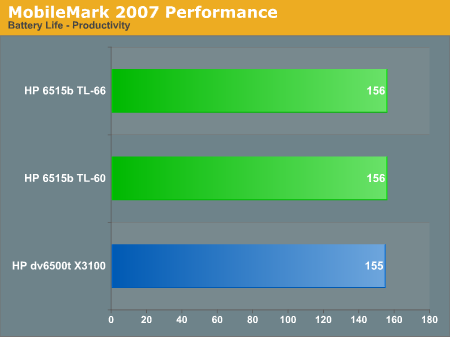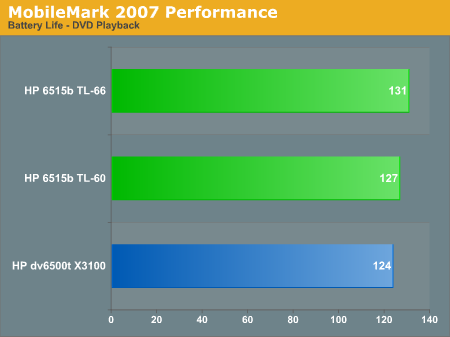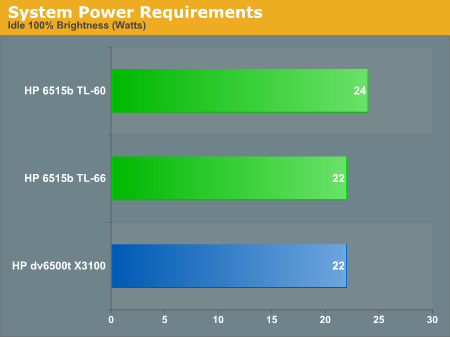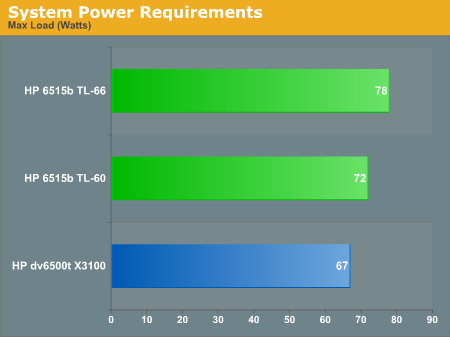Mobile Platform Wars: AMD vs. Intel
by Jarred Walton on October 5, 2007 9:10 AM EST
Battery Life and Power Requirements
The final area that we need to at least look at briefly is the power requirements and battery life offered up by the two different platforms. Again, it is very important to remember that the HP dv6500t has a larger screen, which may require a couple more watts than the screen on the 6515b. That could translate into anywhere from 0 to 30 minutes of battery life under the test conditions. The 6515b also has a 55WHr battery compared to a 47WHr battery, so if power requirements are equal the 6515b should end up lasting longer. We do have MobileMark 2007 now, which we will be using for future battery performance evaluations. We ran the DVD Playback and Productivity portions of the benchmark.



As we already discussed, perhaps the best news is that the TL-66 either matches or improves on the battery life offered by the TL-60 while also increasing performance. Unfortunately, it does this at the penalty of increasing CPU costs by about $200 - roughly twice the price of the TL-60. In contrast, the battery life of the dv6500t is slightly lower, but considering the difference in LCDs and batteries it seems to be the more frugal laptop in terms of power use. Since we aren't able to do a true apples-to-apples comparison, we can't say for sure, but the AMD system only offers at best 6% more battery time with its 17% larger battery. Looking at the power requirement numbers will make this a bit clearer.


Idle power draw for the dv6500t and the 6515b with a TL-66 are the same at 22W, with the TL-60 using slightly more power. Once we crank up the load on the system, however, both AMD configurations end up using 5W and 11W (TL-60 and TL-66, respectively) more than the Intel laptop. The "max load" results shown above involve running Folding@Home SMP at the same time as we run a game in order to fully stress all CPU cores as well as the GPU.
To further isolate the source of the power use, we ran the same tests individually to stress just the CPU along with the GPU and one CPU core. We also included minimum and maximum power draw by decreasing/increasing the display brightness. These results are summarized below.
The most interesting aspect of this table is to look at the difference between idle power draw and 100% CPU load, as that allows us to remove the LCD power requirements from the equation. While we can't say which CPU is better at reducing power requirements at idle (due to the aforementioned platform differences), we can clearly conclude that the Intel CPU requires less power to do more work at load. The power delta is 35 W for the T7300, 39 W for the TL-60, and 48 W for the TL-66. AMD does well at reducing their idle power requirements, but when the CPU is actually working Intel leads by a relatively large margin.
The final area that we need to at least look at briefly is the power requirements and battery life offered up by the two different platforms. Again, it is very important to remember that the HP dv6500t has a larger screen, which may require a couple more watts than the screen on the 6515b. That could translate into anywhere from 0 to 30 minutes of battery life under the test conditions. The 6515b also has a 55WHr battery compared to a 47WHr battery, so if power requirements are equal the 6515b should end up lasting longer. We do have MobileMark 2007 now, which we will be using for future battery performance evaluations. We ran the DVD Playback and Productivity portions of the benchmark.



As we already discussed, perhaps the best news is that the TL-66 either matches or improves on the battery life offered by the TL-60 while also increasing performance. Unfortunately, it does this at the penalty of increasing CPU costs by about $200 - roughly twice the price of the TL-60. In contrast, the battery life of the dv6500t is slightly lower, but considering the difference in LCDs and batteries it seems to be the more frugal laptop in terms of power use. Since we aren't able to do a true apples-to-apples comparison, we can't say for sure, but the AMD system only offers at best 6% more battery time with its 17% larger battery. Looking at the power requirement numbers will make this a bit clearer.


Idle power draw for the dv6500t and the 6515b with a TL-66 are the same at 22W, with the TL-60 using slightly more power. Once we crank up the load on the system, however, both AMD configurations end up using 5W and 11W (TL-60 and TL-66, respectively) more than the Intel laptop. The "max load" results shown above involve running Folding@Home SMP at the same time as we run a game in order to fully stress all CPU cores as well as the GPU.
To further isolate the source of the power use, we ran the same tests individually to stress just the CPU along with the GPU and one CPU core. We also included minimum and maximum power draw by decreasing/increasing the display brightness. These results are summarized below.
| System Power Draw (at outlet with battery removed) | ||||
| Idle | 100% CPU | Gaming | Max Load | |
| HP 6515b TL-60 | 18-24 | 57-63 | 67 | 72 |
| HP 6515b TL-66 | 16-22 | 64-70 | 71 | 78 |
| HP dv6500t | 16-22 | 51-57 | 62 | 67 |
The most interesting aspect of this table is to look at the difference between idle power draw and 100% CPU load, as that allows us to remove the LCD power requirements from the equation. While we can't say which CPU is better at reducing power requirements at idle (due to the aforementioned platform differences), we can clearly conclude that the Intel CPU requires less power to do more work at load. The power delta is 35 W for the T7300, 39 W for the TL-60, and 48 W for the TL-66. AMD does well at reducing their idle power requirements, but when the CPU is actually working Intel leads by a relatively large margin.










33 Comments
View All Comments
Foxy1 - Friday, October 5, 2007 - link
Honestly, who cares about AMD v. Intel when there are more important things in life....like OU v. Texas - Go Sooners!JumpingJack - Sunday, October 7, 2007 - link
Hook 'em Horns!!Xenoterranos - Friday, October 5, 2007 - link
Here I was expecting some sort of exciting outcome.Seriously, you should have called this article, "Salt vs. Wounds: The Continuing Saga of AMD".